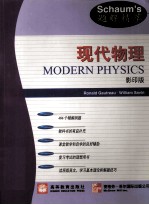图书介绍
现代物理 英文pdf电子书版本下载

- (美)(R.戈特罗)Ronald Gautreau,(美)(W.萨文)William Savin编著 著
- 出版社: 北京:高等教育出版社
- ISBN:7040087561
- 出版时间:2000
- 标注页数:338页
- 文件大小:65MB
- 文件页数:349页
- 主题词:
PDF下载
下载说明
现代物理 英文PDF格式电子书版下载
下载的文件为RAR压缩包。需要使用解压软件进行解压得到PDF格式图书。建议使用BT下载工具Free Download Manager进行下载,简称FDM(免费,没有广告,支持多平台)。本站资源全部打包为BT种子。所以需要使用专业的BT下载软件进行下载。如 BitComet qBittorrent uTorrent等BT下载工具。迅雷目前由于本站不是热门资源。不推荐使用!后期资源热门了。安装了迅雷也可以迅雷进行下载!
(文件页数 要大于 标注页数,上中下等多册电子书除外)
注意:本站所有压缩包均有解压码: 点击下载压缩包解压工具
图书目录
PART Ⅰ THE SPECIAL THEORY OF RELATIVITY 3
CHAPTER 1 GALILEAN TRANSFORMATIONS 3
1.1 Events and Coordinates 3
1.2 Galilean Coordinate Transformations 4
1.3 Galilean Velocity Transformations 4
1.4 Galilean Acceleration Transformations 4
1.5 Invariance of an Equation 4
CHAPTER 2 THE POSTULATES OF EINSTEIN 10
2.1 Absolute Space and the Ether 10
2.2 The Michelson-Morley Experiment 10
2.3 Length and Time Measurements—A Question of Principle 10
2.4 The Postulates of Einstein 11
CHAPTER 3 THE LORENTZ COORDINATE TRANSFORMATIONS 15
3.1 The Constancy of the Speed of Light 15
3.2 The Invariance of Maxwell's Equations 16
3.3 General Considerations in Solving Problems Involving Lorentz Transformations 16
3.4 Simultaneity 16
CHAPTER 4 RELATIVISTIC LENGTH CONTRACTION 20
4.1 The Definition of Length 20
CHAPTER 5 RELATIVISTIC TIME DILATION 23
5.1 Proper Time 23
5.2 Time Dilation 23
CHAPTER 6 RELATIVISTIC SPACE-TIME MEASUREMENTS 27
CHAPTER 7 RELATIVISTIC VELOCITY TRANSFORMATIONS 37
7.1 The Lorentz Velocity Transformations and the Speed of Light 37
7.2 General Considerations in Solving Velocity Problems 38
7.3 The Relativistic Doppler Efrect 38
CHAPTER 8 MASS,ENERGY,AND MOMENTUM IN RELATIVITY 45
8.1 The Need to Redefine Classical Momentum 45
8.2 The Variation of Mass with Velocity 45
8.3 Newton's Second Law in Relativity 46
8.4 Mass and Energy Relationship:E=mc2 46
8.5 Momentum and Energy Relationship 46
8.6 Units for Energy and Momentum 47
8.7 General Considerations in Solving Mass-Energy Problems 47
PART Ⅱ THE QUANTUM THEORY OF ELECTROMAGNETIC RADIATION AND MATTER 59
CHAPTER 9 ELECTROMAGNETIC RADIATION—PHOTONS 59
9.1 The Theory of Photons 59
9.2 The Photoelectric Efrect 60
9.3 The Compton Effect 61
9.4 Pair Production and Annihilation 62
9.5 Absorption of Photons 63
CHAPTER 10 MATTER WAVES 80
10.1 De Broglie Waves 80
10.2 Experimental Verification of De Broglie's Hypothesis 81
10.3 The Probability Interpretation of De Broglie Waves 82
10.4 The Heisenberg Uncertainty Principle 83
PART Ⅲ HYDROGENLIKE ATOMS 103
CHAPTER 11 THE BOHR ATOM 103
11.1 The Hydrogen Spectrum 103
11.2 The Bohr Theory of the Hydrogen Atom 103
11.3 Emission of Radiation in Bohr's Theory 104
11.4 Energy Level Diagrams 107
11.5 Hydrogenic Atoms 107
CHAPTER 12 ELECTRON ORBITAL MOTION 117
12.1 Orbital Angular Momentum from a Classical Viewpoint 117
12.2 Classical Magnetic Dipole Moment 118
12.3 Classical Energy of a Magnetic Dipole Moment in an External Magnetic Field 119
12.4 The Zeeman Experiment 119
12.5 Quantization of the Magnitude of the Orbital Angular Momentum 119
12.6 Quantization of the Direction of the Orbital Angular Momentum 120
12.7 Explanation of the Zeeman Effect 120
CHAPTER 13 ELECTRON SPIN 126
13.1 The Stern-Gerlach Experiment 126
13.2 Electron Spin 127
13.3 Spin-Orbit Coupling 128
13.4 Fine Structure 128
13.5 Total Angular Momentum(The Vector Model) 129
PART Ⅳ MANY-ELECTRON ATOMS 135
CHAPTER 14 THE PAULI EXCLUSION PRINCIPLE 135
14.1 Quantum.Mechanical Systems with More Than One Electron 135
14.2 The Pauli Exclusion Principle 135
14.3 A Single Particle in a One-Dimensional Box 135
14.4 Many Particles in a One-Dimensional Box 136
CHAPTER 15 MANY-ELECTRON ATOMS AND THE PERIODIC TABLE 140
15.1 Spectroscopic Notation for Electron Configurations in Atoms 140
15.2 The Periodic Table and an Atomic Shell Model 141
15.3 Spectroscopic Notation for Atomic States 142
15.4 Atomic Excited States and LS Coupling 142
15.5 The Anomalous Zeeman Effect 143
CHAPTER 16 X-RAYS 157
16.1 X-Ray Apparatus 157
16.2 Production of Bremsstrahlung 157
16.3 Production of Characteristic X-Ray Spectra 158
16.4 The Moseley Relation 160
16.5 X-Ray Absorption Edges 160
16.6 Auger Effect 161
16.7 X-Ray Fluorescence 161
PART Ⅴ NUCLEAR PHYSICS 173
CHAPTER 17 PROPERTIES OF NUCLEI 173
17.1 The Nucleons 173
17.2 Nucleon Forces 174
17.3 The Deuteron 174
17.4 Nuclei 174
17.5 The Nucleus as a Sphere 175
17.6 Nuclear Binding Energy 175
CHAPTER 18 NUCLEAR MODELS 181
18.1 Liquid Drop Model 181
18.2 Shell Model 182
CHAPTER 19 THE DECAY OF UNSTABLE NUCLEI 193
19.1 Nuclear Decay 193
19.2 The Statistical Radioactive Decay Law 193
19.3 Gamma Decay 194
19.4 Alpha Decay 194
19.5 Beta Decay and the Neutrino 195
CHAPTER 20 NUCLEAR REACTIONS 207
20.1 Notation 207
20.2 Classification of Nuclear Reactions 207
20.3 Laboratory and Center-of-Mass Systems 208
20.4 Energetics of Nuclear Reactions 209
20.5 Nuclear Cross Sections 210
20.6 Nuclear Fission 210
20.7 Nuclear Fusion 211
CHAPTER 21 PARTICLE PHYSICS 224
21.1 Particle Genealogy 224
21.2 Particle Interactions 224
21.3 Conservation Laws 226
21.4 Conservation of Leptons 227
21.5 Conservation of Baryons 227
21.6 Conservation of Strangeness 227
21.7 Conservation of Isotopic Spin and Parity 227
21.8 Short-Lived Particles and the Resonances 228
21.9 The Eightfold Way 229
21.10 Quarks 230
PART VI ATOMIC SYSTEMS 245
CHAPTER 22 MOLECULES 245
22.1 Molecular Bonding 245
22.2 Excitations of Diatomic Molecules 246
CHAPTER 23 KINETIC THEORY 259
23.1 Average Values in a Gas 259
23.2 The Ideal Gas Law 259
CHAPTER 24 DISTRIBUTION FUNCTIONS 268
24.1 Discrete Distribution Functions 268
24.2 Continuous Distribution Functions 269
24.3 Fundamental Distribution Functions and Density of States 270
CHAPTER 25 CLASSICAL STATISTICS:THE MAXWELL-BOLTZMANN DISTRIBUTION 276
CHAPTER 26 QUANTUM STATISTICS:FERMI-DIRAC AND BOSE-EINSTEIN DISTRIBUTIONS 287
26.1 Fermi-Dirac Statistics 287
26.2 Bose-Einstein Statistics 288
26.3 High-Temperature Limit 288
26.4 Two Useful Integrals 289
26.5 Blackbody Radiation 289
26.6 Free Electron Theory of Metals 292
26.7 Specific Heats of Crystalline Solids 296
26.8 The Quantum-Mechanical Ideal Gas 301
26.9 Derivation of the Quantum Distribution Functions 305
CHAPTER 27 SOLIDS 309
27.1 The Band Theory of Solids 309
27.2 Superconductivity 318
Appendix 325
Some Fundamental Constants in Convenient Units 325
Some Useful Conversions 325
Masses of Some Particles 325
Masses of Neutral Atoms 326
Index 333